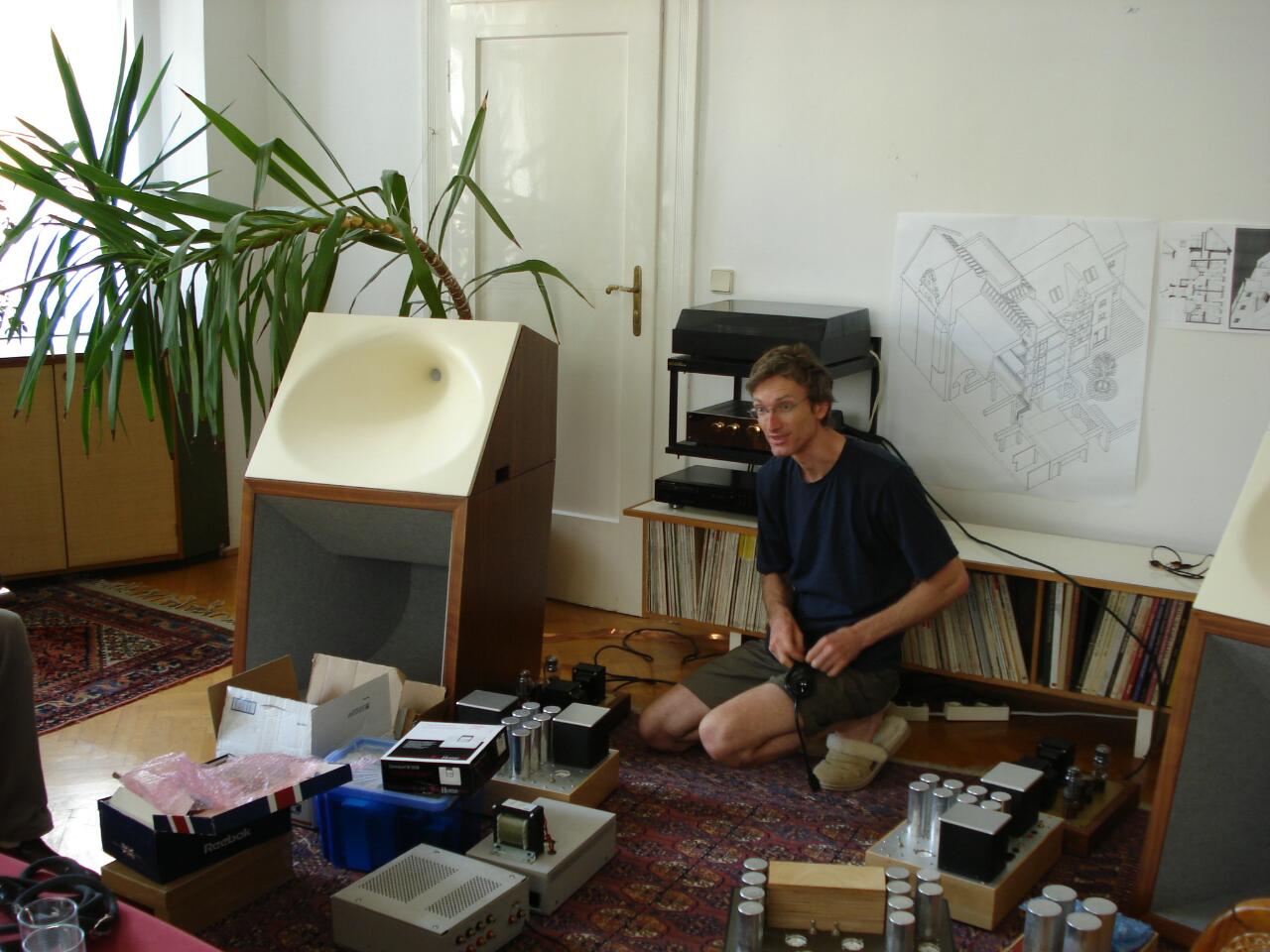

![]()
The
Tube Amplifier Magic of Germany's Thomas Mayer
September 2009
/ December 2010
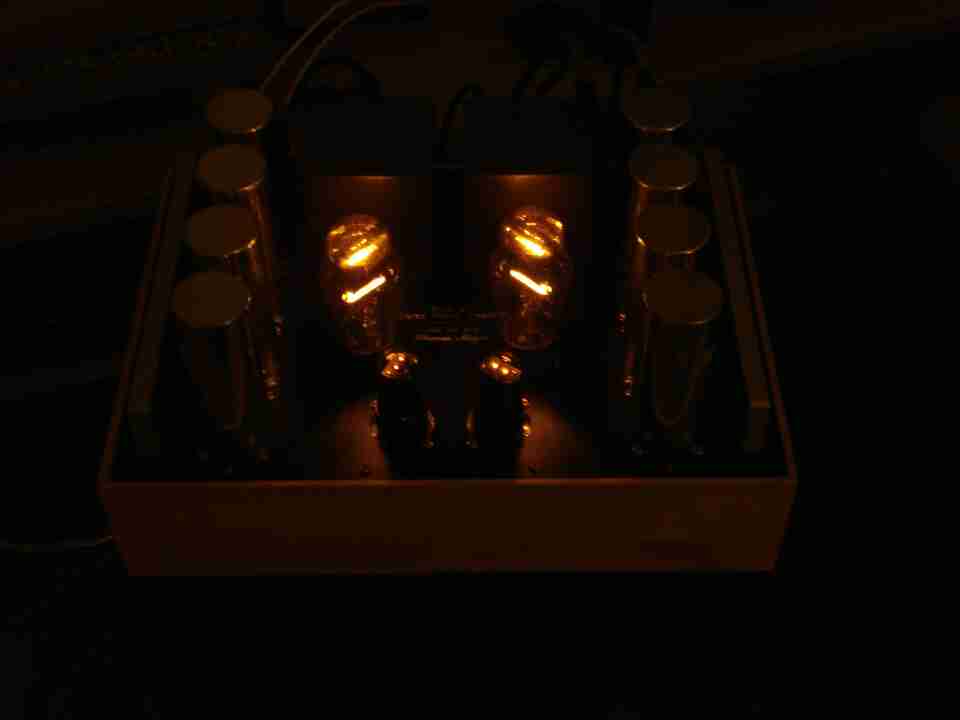
When I met Thomas Mayer the first time about eight years ago at a music-listening evening at my friend Joe's place in Vienna, I had just started to learn about the great musical pleasure a good SE tube amp could deliver. At the time, Thomas and Joe were DIY-tube aficionados (the former in Munich, the latter in Vienna) who, due to the fact that they were not happy with the equipment offered in the audio market, built their own amps using techniques, I'd never heard of before. They were light-years ahead of me in their experiences with tube amps, but always shared their knowledge and passion for their hobby with others. You can see some of the equipment they built on my website, by the way.
Both prefer choke input filters instead of the more common capacitor input filters. Usually several LC filter stages for power supplies, filament supplies, dc filtering as well as interstage transformer coupling of driver and output tubes. There are rumors that the Lundahl company of Sweden did fairly well the last decade due to the many hundreds of irons (chokes, transformers, etc.) which mainly Thomas and Joe had used in their designs.
The results proved them right, though. Their designs were not only extremely heavy, due to the weight of the iron used, but also impressive and excellent sounding pre- and power-amplifiers. Their only caveat was that you couldn't easily try out these amps, because Thomas and Joe both build everything around three-phase power supplies as that's, in their opinion, the best power source available. Of course, however, the appropriate power outlets are not standard in a normal German or Austrian household.
There is a change for the better now though, because Thomas, inspired by a discussion in a German audio forum, decided to design an SE ended stereo tube amp in kit form for around EUR 1,000 based on the 6CB5A output tube using a normal single-phase power supply. The goal was not only to challenge the more and more common Chinese tube amps on the market, but also to come up with a better sounding, more reliable and electrically safe amp.
Said and done. Within months Thomas developed a full kit version of the desired amp.
After that, due to the positive response to this first 'entry level' amp, he designed a full range of amps, as well as a preamp with RC phono, using normal single-phase power supplies.
All of these amps will be available in kit form with a superb price/value ratio, also adding the extra thrill of building your tube amp by yourself. People who don't trust their own ability to build the full version of an amp don't have to worry, because in such cases, Thomas and his audio partner Rolf Bayer can provide professional help in fully and flawlessly assembling the amp of choice for some extra money. Definitely great service.
***
So let's see how the chances are to finally reach Audio Nirvana...
But, before I tell you about my own listening experiences in my current system with two of Thomas' power amp designs, let's look at the amplifier kits he offers:
The entry-level power amp is a Stereo SE 6CB5A power amplifier with RC coupling between driver tube (a 6N7, incidentally) and external power supply in a more simple version with silicium rectifiers in a steel chassis. This amp will be around EUR 1,000 in kit form.
The 6CB5A is a beam power tetrode which was widely used in TV sets in their Horizontal Deflection Amplifiers (which means that many NOS tubes are available). Thomas uses this tube in triode mode at around 450V B+ voltage which then provides solid 8 watts SE power, similar to the highly regarded 300B DHT. But back to the Mayer amps...
The next step is a 6CB5A SE stereo power amp with external power supply, tube rectifier and choke as well as oil caps in a nice-looking wooden frame fitting the wooden frame of the driver/output section. For both versions, the output transformers are Lundahl.
Next on the list is a 6CB5A SE stereo amp with Lundahl interstage coupling and Lundahl or Tango output transformers (the Tango version adds some extra money to the kit price) in one bigger wooden frame. I had this version with Tangos for an enhanced listening period in my home with great results!
The
same is also available as two mono blocks (looks nicer, in my
opinion, due to the fact that the wooden cabinet is reduced in height
and possibly adds a little bit more power supply capacity, because
there is one power transformer, choke and rectifier tube per channel).
Then,
we have a pair of 6CB5A PP mono block amps with Tango transformers,
which deliver 2 x 15 W and fully run in Class A.
For all the above amps the driver tube is a 6N7, a tube with excellent linearity and also one which is available in NOS quality and doesn't break the bank.
Thomas informed me that in all tube rectified/Choke ps versions, he uses multiple LC filtering stages. In addition, the B+ voltage of each channel is buffered with its own LC stage. Most of these reactive loads come from Lundahl in Sweden, one of the leading high performance audio transformer manufacturers in the world. Some of the chokes, as well as the power transformer, are handmade in Germany to Thomas' specifications. Wow, regarding parts quality there is definitely a BIG DIFFERENCE to all of the nowadays-so-popular Chinese tube amps.
OK, so that's one part of the amplifier line, the 6CB5A line. This line is accompanied by a line stage with built-in RC coupled passive MM RIAA phono stage. Line and phono are based on octal triodes and the preamp comes with output transformers and a volume step transformer. Input tube for phono is a 6SL7 then 6N7 and 6SN7 in the line stage.
For audio connoisseurs, there are three more power amps available. These are true DHT SE stereo designs (driver tube is here again the 6N7).
-
one with switchable 45/2A3 output tubes, LUNDAHL interstage transformer coupled and integrated power supply. Also, here one has the choice between Lundahl or Tango output transformer (the latter choice adds an extra charge to the kit price).
-
a two-chassis SE stereo premium amplifier around the superb 801A DHT triode (a tungsten filament triode with gorgeous glow) with 3.5 W output power per channel and finally
-
a two-chassis SE stereo premium amplifier around the legendary WE 300B DHT triode with 2 x 8 W of SE triode power.
To quote Thomas about the technique of his personal favorite, the 801A amp: "The external power supply has two separate stages for driver and output tubes, extensive filtering with multiple LC stages, DC heating with two inductors for each 801A and only oil capacitors in the power supply. B+ Voltage is 680V and all together 20 pieces of iron (!) are used in amplifier and power supply."
Wow, impressive stuff and looks cool, too. The power supply is heavy, though. Will spare you the visit to a fitness center, because all of your audio friends will want you to come by with this amp, I'm sure ;-)
The 300B amp is as complex plus has a switch to change the heating for the output tube between AC and DC. The icing on the cake is that it comes with a pair of WE 300Bs! According to Thomas, the only 300B which really sings.
Oh man, Thomas, you make audio dreams come true. This is world-class amplifier building, that's for sure. (If you are interested, you can contact Thomas via his email thomas'at'vinylsavor.de for options and prices of his amp line).
The only slight criticism I have regarding the parts used are the ceramic tube sockets Thomas choose for rectifier, driver and output tubes. They look great and are well built, but when you put a tube into the socket, it's not easy to get the tube stay fixed into its socket due to the snap-in technique the tube socket provides. Two times during auditioning of the 6CB5A, the tube got a little bit loose in its base. Nothing dramatic, but for amps with this superb quality, I would consider providing mechanically-better designed tube sockets.
***
Thank you for being so patient and reading so far, because finally we come to some listening impressions...
Thomas and Rolf visited us in Vienna in early August 2009 and had most of the amps with them. I was part of one listening session with David Haigner's 97dB efficiency Betahorns at VE's place. VE is an architect, the designer of the aesthetics and the visualization of the new Haigner Gammahorns, and a really nice guy, by the way.
The equipment used was an EAR 868 preamp, a Roksan Xerxes/Artemiz TT with Roksan Shiraz cartridge, built-in phono stage and David's excellent Njoe Tjoebe CD player as sources. Here are some photos of the session:
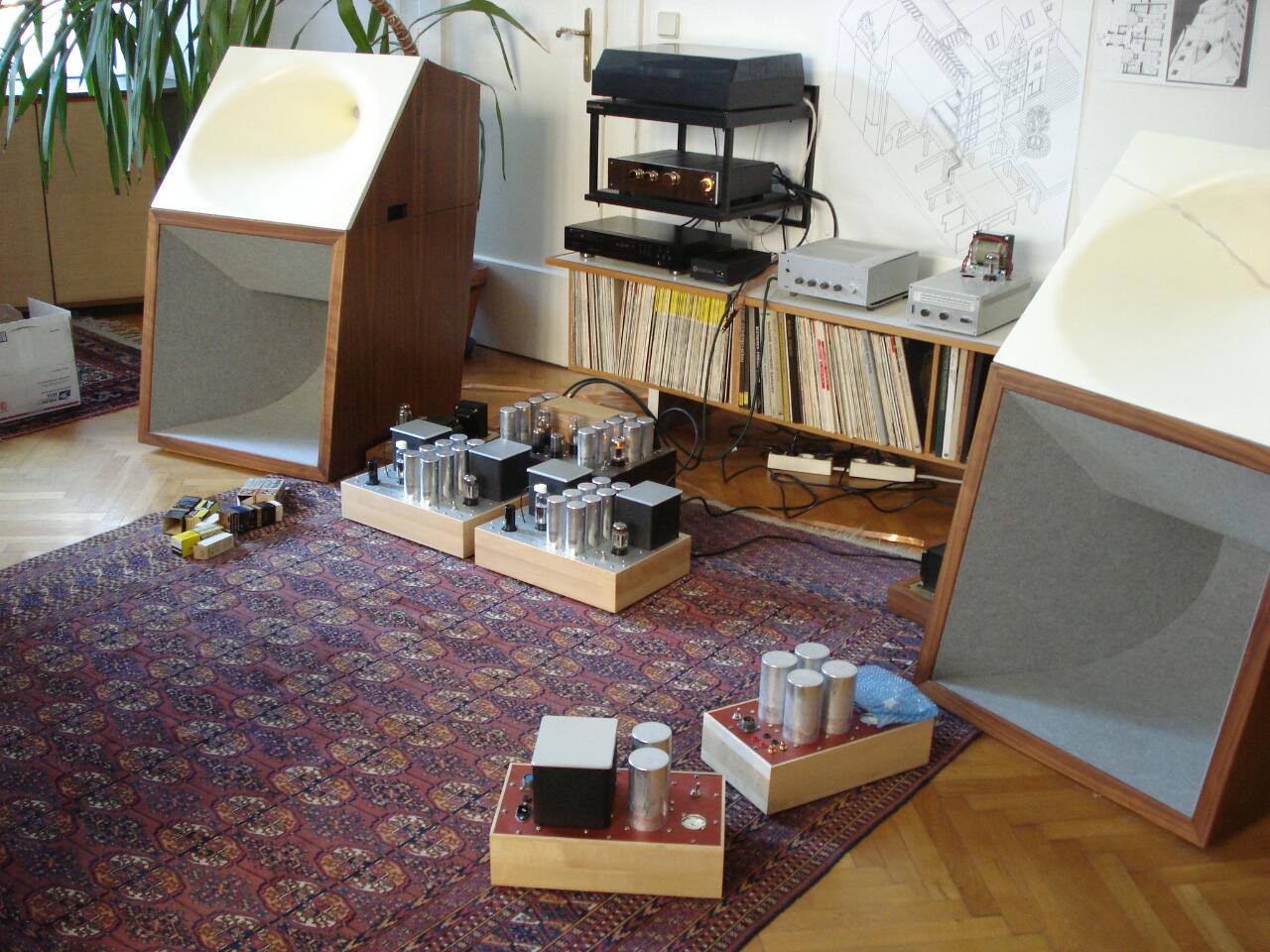
The
auditioning system
with some of the Thomas Mayer amps (mainly 6CB5A versions). As you
can see, the base plates of the amps come in different colors. There
are also a couple of wood choices for the frames (Both options are
included in the prices of the various kits)
|
SE
DHT 801A Amp and SE DHT 45/2A3 getting
ready for the listening comparison... |
Unpacking
and
setting up the
listening system... |
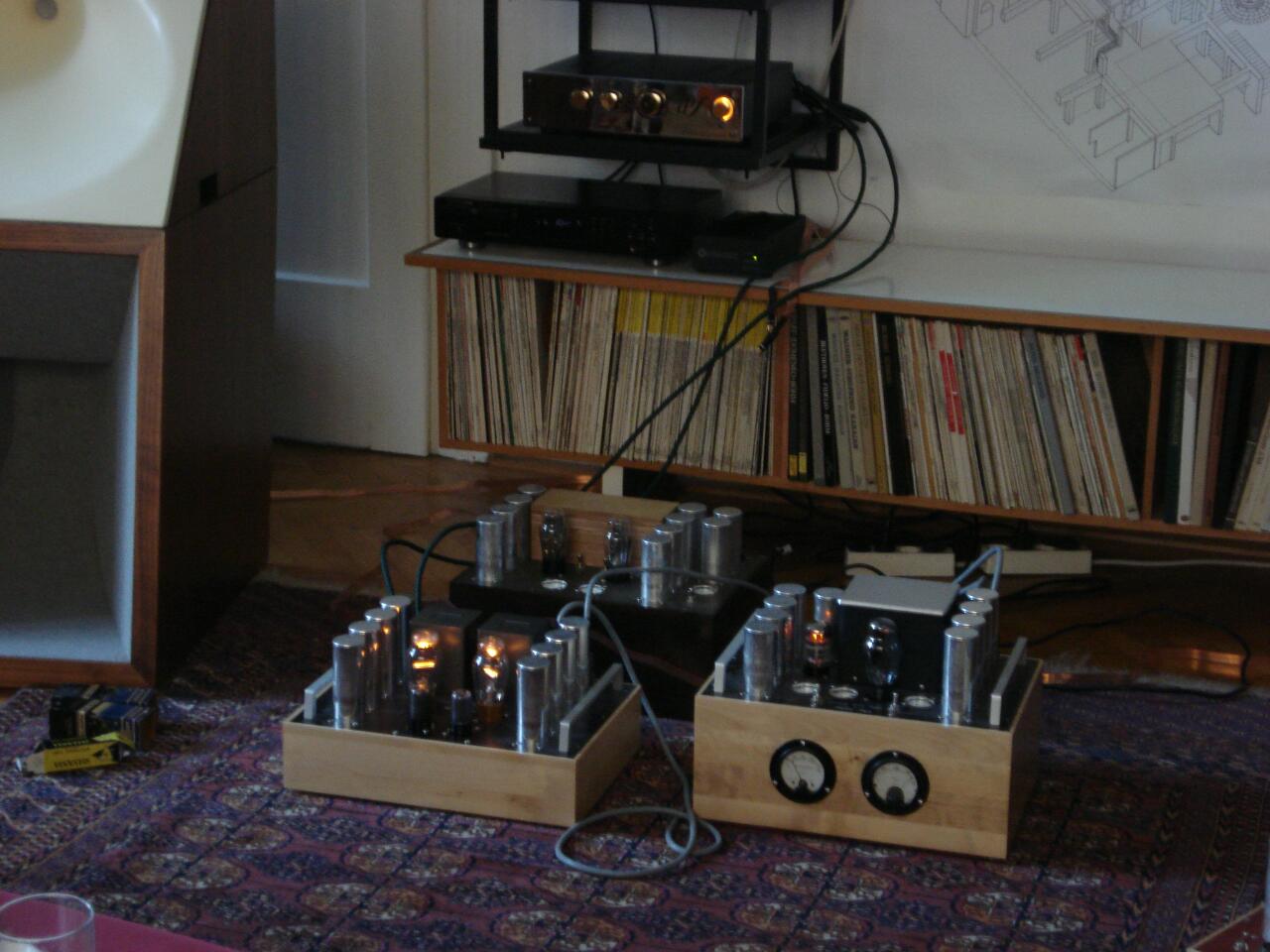
The impressive sounding SE DHT 801A stereo amp on the floor on the left side with external universal ps next to it. This ps can also be used together with the 300B SE amp, Thomas Mayer builds. Nice touch. Behind you can see the 45/2A3 SE DHT stereo amp.
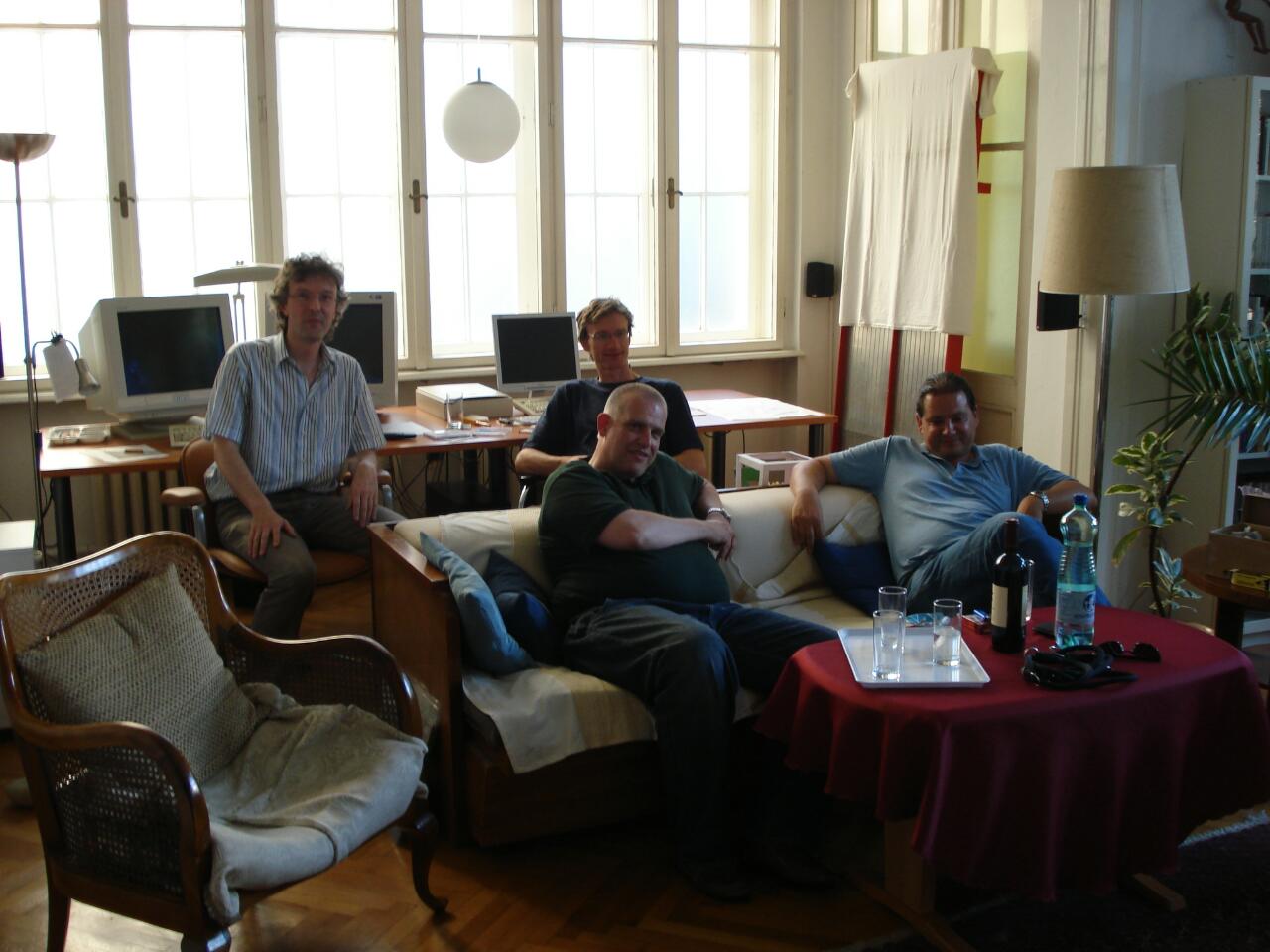
Relaxed
atmosphere in Vienna...
First, we played some classical chorus music with my Welborne Labs SE DHT 2A3 Moondog Monos, and there were colorful mids and good stage and depth as well as extended airy treble. But also, it was clearly to be heard that the Moondogs had power limitations to fill this 35-square-meter room with music.
Next, was Thomas Mayer's 45/2A3 DHT SE stereo amp with the same pair of 2A3s we had heard before. This definitely worked better. There was more quietness between the notes, everything was clearer and more stable. So apparently, the LC coupling between driver and output tube and the more extensive ps filtering won against the conventional RC coupling of my Moondogs.
Hmm, not easy for me, because I enjoy my Moondogs a lot in my system, but the better amp was definitely the one Thomas had built.
Then, we tried the same amp with a pair of vintage 45s, and man, this is the real stuff. So sweet and full of emotion - incredible - although, not enough power for the Betahorns when you're listening to rock music. If you are lucky and own a min. 103 dB horn system and a medium to high gain preamp then Thomas' 45/2A3 amp, especially when used with the 45s, is a clear winner and will get you hooked with musical drama, emotion, color and sweetness. In such a system, this 45 amp will rock!
(Only caveat: The 45/2A3 amp is a low-sensitive amp due to only one driver stage and the moderate amplification factor of the output tubes, and therefore, will possibly not work well in a system with a passive preamp or a low-gain preamp; something to try out first before you make a final decision to buy it.)
Next, were the 6CB5A SE monos with Lundahl interstage and output transformers. Wow, and now the Betas sang. 2 x 8 watts were enough to shake the house. In my view, that's what an amp has to do. Ok, there wasn't as much drama, color and sweetness in comparison with the flee powered 45s (2 x 1.5 W), but there was an authority in the music driving the Betas I had missed with all of other amps thus far. My decision was clear, the SE stereo amp version with the same technology but the Tango output transformers were the amps I wanted to try out in my system for a longer period of time.
Finally, we gave the 801A DHT SE stereo amp a try, and although it had only half of the power in comparison to the 6CB5A, this worked really well. The bass was great, superbly defined and the midrange had a lot of the emotion of the 45, although it was not as sweet and charming. The highs were superbly detailed without being too much. The musical flow was great to my ears. Another amp to add to my personal favorite list.
The session was exciting and a lot of fun. Unfortunately, I had to leave in the early evening to meet with my family. The others stayed longer and enjoyed music, drinks and good food.
The next day, there was a listening session at the home of Reno Barth, who owns a pair of Haigner Alphahorns, David Haigner's state-of-the-art horn loudspeaker. I couldn't take part, but according to what I heard from Reno, David, Thomas and Rolf, the 45s drove the Alphas very well, although due to the huge listening room (about 60 square meters) there were limitations audible with orchestral as well as rock music. However, the star of the show was reportedly the 801A DHT SE stereo amp. David was really impressed. This amp also worked superbly with the entry-level Haigner Rho.
Thomas and Rolf had to leave the same evening to travel back to Munich, but fortunately, left four amps with us for an extended listening period. (The 45/2A3, 6CB5A SE stereo in top configuration, a PP stereo with interstage and Tango OPTs and finally the 801A SE stereo amp). Thanks a lot Thomas!
A
great weekend was over with a load of positive impressions. I
learned a lot about how good a tube amp can sound, when you know how
to use iron (transformer, chokes and inductors) optimally in an audio
tube amplifier.
Musically yours,
Norbert
PS: Here are my personal listening experiences with the SE stereo 6CB5A and 801A DHT SE stereo amps:
Ok, first I lived a week with the 6CB5A (with Lundahl interstage and Tango XE-20S output transformers) connected to my system. (See current system page for more info about my set up.) The amp confirmed everything I had heard with the Betas a week earlier, and they drove my Haigner-moded Altec Valencias with ease. This amp is fast and has superb bass performance. The bass is tight and dynamic when bass notes are played through an e-bass, but it also has many colorful shadings when a string bass or cello is the performer. Mids were great too. Not as magical as a good DHT can sound, but extremely clear and definitely with tube charm. The treble section was great too, with a lot of detail but not as extended as the best low wattage DHTs. For me this amp is definitely a 300B killer!
You want an example why?
OK, my WE91 SE 300B monos, which I bought as a kit version from DIY Hifi Supply in Hong Kong, had no chance at all. These amps have a tube rectified ps with choke, are RC coupled between driver and output tube and the latter is DC heated via a highly-regarded Tentlabs DC heater module, so all in all are more conventionally built than the Mayer 6CB5A SE amp. The bass performance of the 300B monos is slow in comparison to the 6CB5A amp, the treble section is less refined - only the mids have the creamy and hypnotic 300B sound. To be fair, the Tango OPTs in the 6CB5A are definitely two steps ahead of the ones used in the WE91 amps. (I have to try better OPTs in the WE91 amps in the near future and will report if and how the amps' performance changes.)
What impressed me the most when listening to all kinds of music with the 6CB5A in the top stereo version was the superb musical flow, the wonderful 3D stage it built within my speakers when a recording is done properly. Finally, I appreciated the darker-than-average background, which lets you hear more information from your vinyl or digital discs. A clear winner, this amp!
At my friend and jazz record collector Alexander's place a week later, we tried the PP 6CB5A stereo amp with interstage transformer and Tango OPTs in his system. Alexander is now the owner of my beloved three-way Haigner monitors, which I had lived with for many years and which provided countless hours of listening pleasure in my dedicated music room. These monitors have an efficiency of 92 dB and should, therefore, be an easy load for the PP amp. Unfortunately, this wasn't the case. Although the amp sounded sweet, with a lot of finesse and detail, it didn't feel like 2 x 15 W in Alexander's system. It also didn't feel as powerful and dynamic as the SE version at my house. And the Valencias are, according to David Haigner, a similar load in terms of efficiency.
When I informed Thomas about our results, he told me that for the PP amp, he used the smallest Tango OPTs, and he will in the future only provide a mono block version of the PP 6CB5A amp, to increase the ps capacity. Furthermore, running a PP amp in full class A for optimum sound quality is, according to Thomas, always a compromise.
I honestly hope that Thomas will give the PP design a try with better fitting OPTs, because the performance I've heard from the SE version has been so great that it would be a bummer not to reach a similar impressive result with the PP version. (I personally would sacrifice having a little bit less sweetness and more bass power, grip and dynamic by possibly running the amps in class AB mode, but I'm no amp designer...) We will definitely try the SE 6CB5A stereo amp in Alexander's system within the next weeks to check if the superb results of this amp can also be reproduced in his chain. I'm highly positive about it and will report about our findings asap.
Save the best for last, so to say, because living for some days now with the Thomas Mayer SE 801A DHT stereo amp is a different musical experience. This is definitely the best amplifier I have had in my system so far. Period! It provides only 3.5 W per channel, but the most powerful, refined and musical 3.5 W I've ever experienced. Due to the Altec mid/treble horn, the Valencia is definitely not the last word in treble resolution, but with the amp in my chain, there is so much more information and resolution, but always with perfect timing. Awesome!
Only
thinking of the chance to listen to this amp with my new Haigner
Gammahorns, which hopefully will be delivered in the next two months,
makes me smile the whole day. The 801A amp is not cheap, and I don't
know how to finance it yet, but it's definitely a statement amplifier
from an incredibly-gifted tube amp designer as well as a work of art.
(And the glow of these output tubes! Absolutely gorgeous. You have to
experience the glow of a tungsten filament DHT in the dark for
yourself, it's wonderful...)
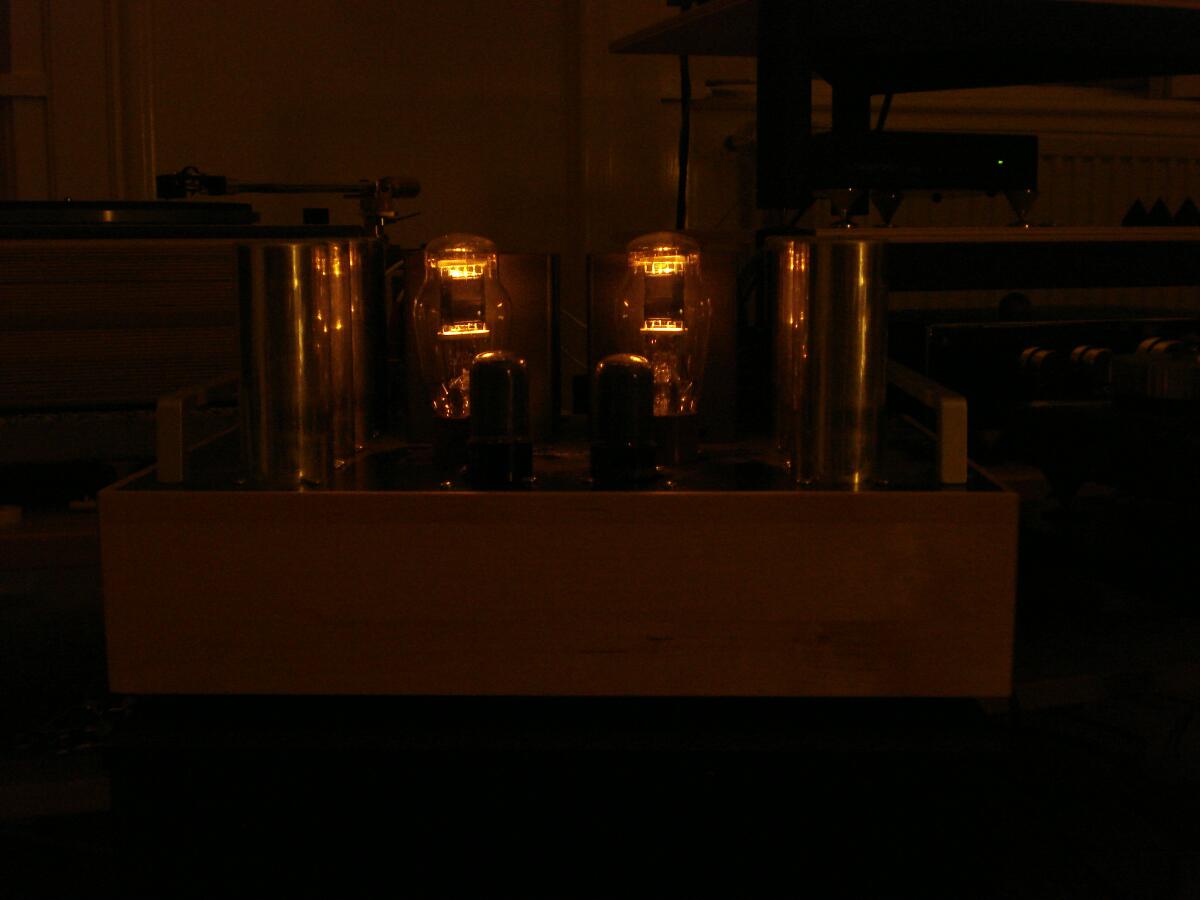
Did
I promise too much...
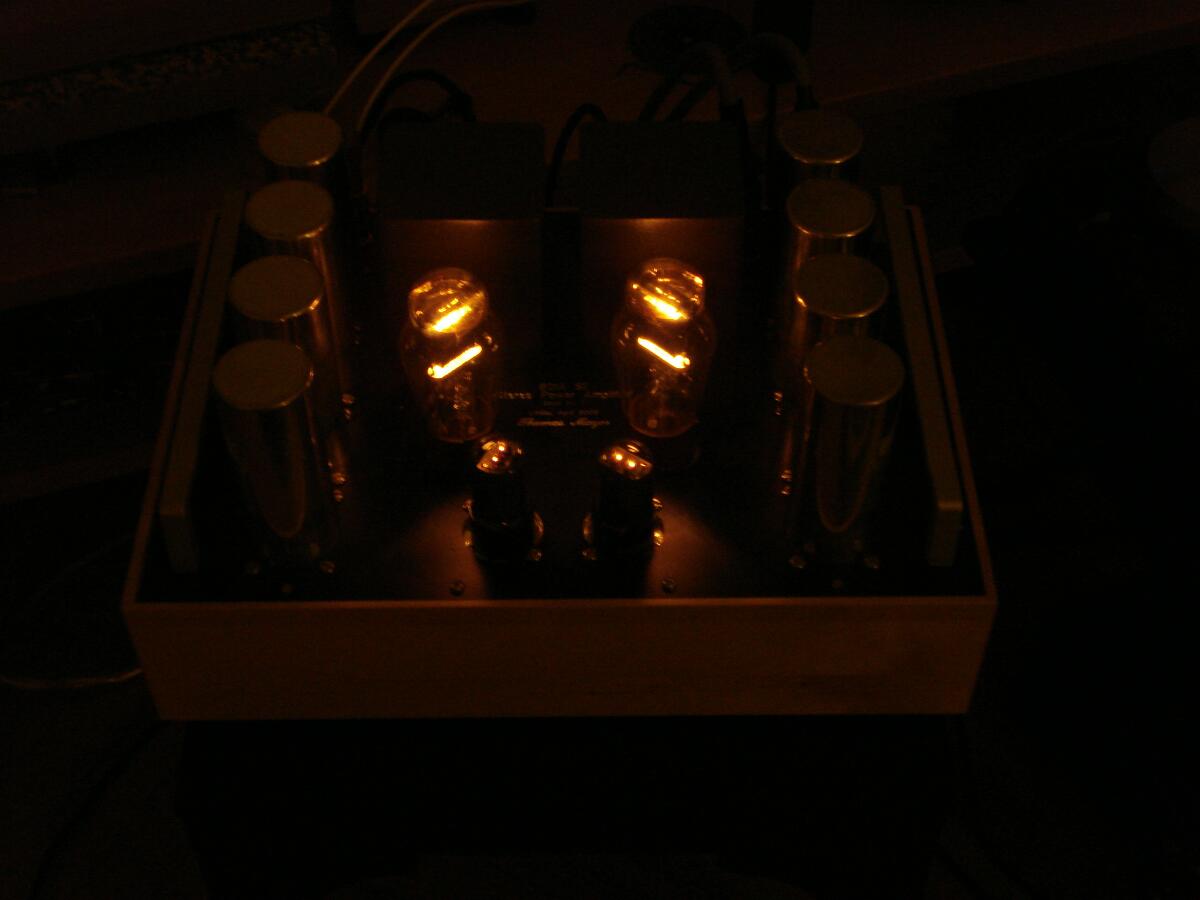
And because of the looks and more importantly these superb musical qualities I can hear with various kinds of music from vinyl and CD, this amp is a true bargain!
No time to write more, I need to play some music, dear readers! :-)
©The
Audio Eagle 2005-2011•
All Rights Reserved • Disclaimer











